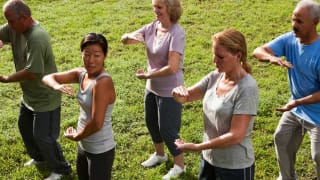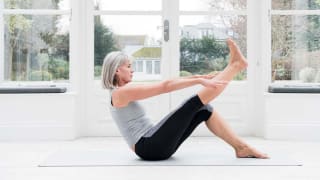T ai chi, which uses slow and gentle movements, may seem like yet another exercise fad. But the practice began as a martial art in China hundreds of years ago, and its health benefits have been the focus of more than 500 studies in the last half-century.
"It's really more like moving meditation, and almost anyone at any age can do it," says a longtime tai chi teacher, Bill Helm, director of the Taoist Sanctuary in San Diego. Here, how tai chi can help you.
How Tai Chi Boosts Health
One plus appears to be better balance. A recent analysis of 10 studies involving older adults, in the Journal of the American Geriatrics Society, found that regular classes reduced falls by 43 percent in those followed for up to a year compared with other exercise. One study suggested it may also cut the chance of being injured in a fall by half.
Tai chi involves slowly shifting your weight from side to side or forward and back, and stepping in circles, all of which improve balance.
"It also helps strengthen your stabilizing muscles, like those in the hips, and improves your body's sense of where it is in space," says Linda Larkey, Ph.D., a professor in the College of Nursing and Health Innovation at Arizona State University.
A review published last year in Canadian Family Physician found that tai chi also helps ease the symptoms of chronic obstructive pulmonary disease, dementia, depression, osteoarthritis, and Parkinson's disease. A similar review found it may help with hypertension, too.
"The mindfulness aspect of tai chi—the breathing, focus, and rhythmic nature of the movements—helps calm the nervous system and reduce inflammation," Larkey says. That can have a positive effect on brain function, pain perception, anxiety, and blood pressure, she notes.
Before You Start
If you're an older adult under a doctor's care or you haven't exercised regularly in awhile, the American Tai Chi and Qigong Association recommends first getting medically cleared for exercise.
But experts say tai chi is safe for most people.
"One reason tai chi programs have been so popular at senior and retirement centers is because it's relatively low intensity, and people seldom get hurt," says Wojtek Chodzko-Zajko, Ph.D., a kinesiologist and dean of the Graduate College at the University of Illinois at Urbana-Champaign.
A 2014 Archives of Physical Medicine and Rehabilitation review found that the most common negatives were minor aches and pains, typically in the knees and back.
What to Expect
In tai chi, an instructor will lead you through a warm-up, followed by a series of flowing moves you'll learn gradually and repeat throughout class. "I tell my students, ‘Nobody here is going to the tai chi Olympics, but we can improve on our current state of health,' " Helm says.
You can also do tai chi with an instructional DVD or online video. (The Arthritis Foundation offers some video clips online.) But a group class may be better; hands-on instruction will help you improve your form and avoid moves that may cause pain.
Community recreation and senior centers and YMCA/YWCAs frequently offer tai chi classes. You can also find them in your area by searching the American Tai Chi and Qigong Association's online directory.
Try a few classes (Helm recommends going at least twice a week for a month) to make sure you feel comfortable and that instruction includes rhythmic breathing, slow arm and leg movements that involve coordination and balance, and an emphasis on clearing or focusing the mind.
"If the class doesn't include these elements, you might not get the same benefits that have been shown in studies," Larkey says.
Keep in mind that as low-intensity exercise, tai chi doesn't meet government physical activity guidelines: 150 minutes of moderate-intensity activity like a brisk walk or 75 minutes of vigorous-intensity activity like jogging, weekly, along with twice-weekly strength sessions.
"If you're using tai chi as a supplement to your more intense routine, that's very good," Chodzko-Zajko says. "If it's being used to substitute for walking or another activity, then that's more of a concern. There's not strong evidence that low-intensity physical activity of any kind is as good for you as meeting the physical activity guidelines."
Editor's Note: This article also appeared in a 2017 issue of Consumer Reports on Health.





















